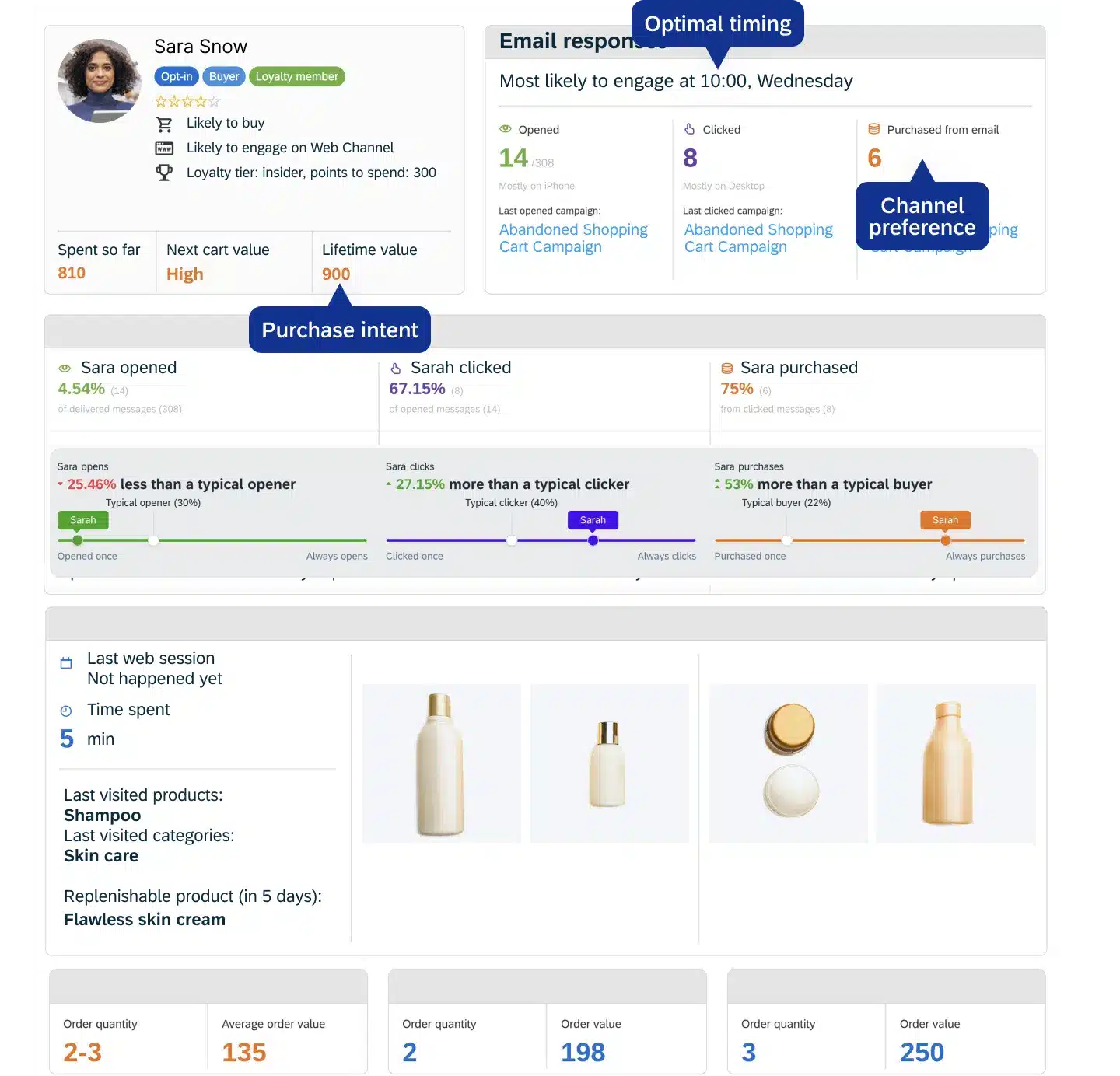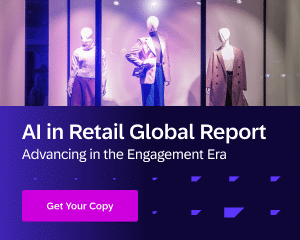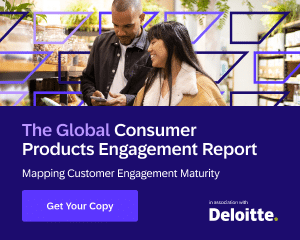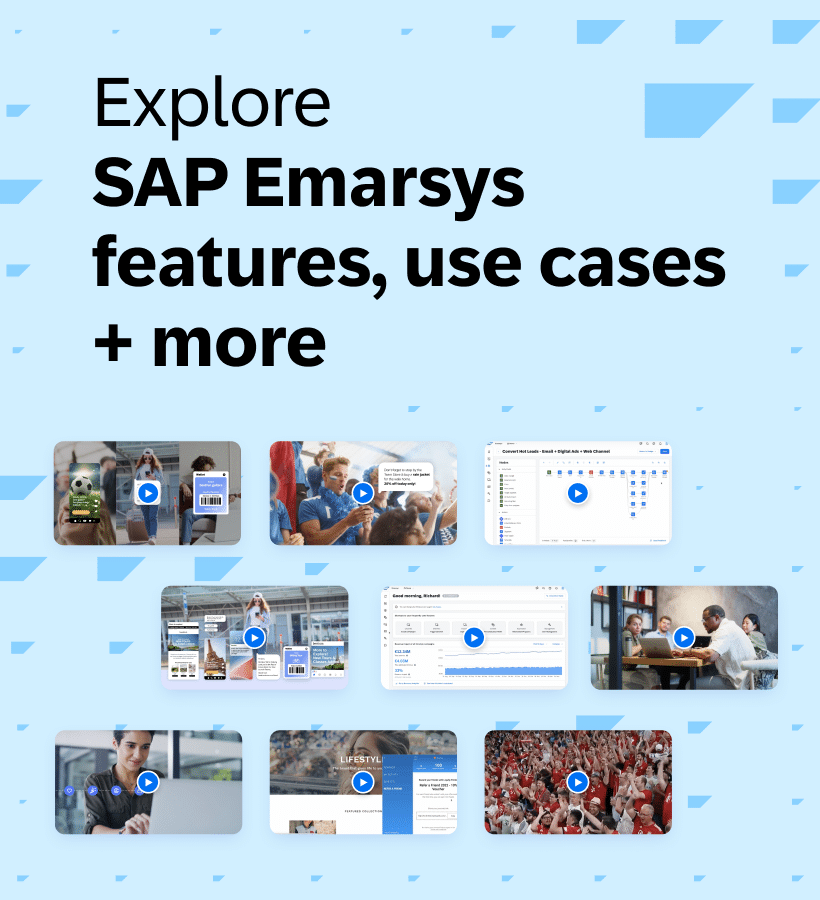Imagine wrapping up a high-performing holiday campaign but noticing inconsistent experiences across channels: while one set of customers gets perfectly personalized promos, another receives generic emails.
Meanwhile, different team members and in-store teams lack visibility into shoppers’ online behaviors, so they miss opportunities to make relevant recommendations or segment them well. Sounds messy, right?
Omnichannel Customer Data is The Key to Enterprise Marketing Success
Today’s customers demand seamless brand interactions no matter where they shop. This is where omnichannel marketing comes in. By leveraging your omnichannel customer data, you’ll be able to deliver consistency and personalization at every touchpoint.
In this guide, we’ll explore how unified data can increase personalization, loyalty, and ROI while overcoming key challenges. We’ll also examine seven ways brands like yours can leverage customer data to drive omnichannel strategies.
7 Ways Brands Power Their Marketing Strategies with Omnichannel Data
Let’s take a look at seven ways brands use data to power their omnichannel marketing, complete with actionable tips:
1. Personalize experiences at scale
Omnichannel customer data enables you to deliver targeted promotions or content to each individual at the right time, no matter how large the audience. You can boost conversions and stretch marketing dollars further by aligning offers with each customer’s lifecycle stage. Based on a unified shopper profile, you can use the following:
- Behavioral segmentation: Group shoppers by purchase histories, site browsing patterns, or repeat visit frequency.
- Dynamic content: This feature displays real-time product recommendations with content that changes automatically based on user data, preferences, or behavior.
- Predictive modeling: Can forecast the best time to send a push notification or which discount a high-value shopper will respond to.
- Anonymous visitor targeting: Deliver targeted messaging even to unidentified visitors through real-time browsing data and signals like cart abandonment. Anonymous or not, these potential buyers still receive personalized content that encourages them to convert faster.
AI-driven Customer Data solutions automate hyper-personalization at scale. You can use AI to enrich your customer data. Based on their likely future actions, such as purchasing or churning, you can provide content and experiences that connect with customers through their preferred communication channels.

Example in action: By setting up this automation to engage with active and churned customers, Petco increased its won-back customers by 15% and accomplished much more.
Discover how SAP Emarsys achieved this for Petco.
2. Break down data silos
Even for large brands undergoing multiple digital transformations, data is often scattered across legacy CRMs, disconnected eCommerce platforms, POS systems, loyalty databases, and social media tools.
Each environment operates in isolation, creating fragmented views of the same customer. This lack of a single source of truth can lead to duplicate marketing efforts, misaligned product recommendations, and inconsistent campaign performance metrics. With omnichannel customer data, you can:
- Create a “single source of truth” or view: By unifying data from CRMs, POS systems, e-commerce platforms, and loyalty tools, brands empower every department—marketing, sales, and operations—with the same real-time insights.
- Enable real-time inventory updates: When stock levels automatically sync across channels, retailers avoid contradictory or outdated figures. This coordination prevents missed sales in-store or online and helps marketing teams accurately promote only in-stock items.
- Out-of-the-box connectors: SAP Emarsys offers pre-built integrations, cutting down months of complex IT work to a fraction of the time. By merging historical and live data sources, these connectors eliminate siloed repositories, allowing cross-department teams to collaborate and make data-driven decisions.
For more guidance on breaking down departmental barriers, check out Break Down the Silos or Break Your Customer Experience.
Quick implementation insight: Cloud migration is frequently essential. Companies mired in legacy architectures risk expansion bottlenecks, as illustrated by Disney’s challenges in scaling omnichannel marketing. Shifting data workflows to a scalable, cloud-based system ensures identity resolution stays accurate and immediate.
Learn more with Disney Theatrical Group: Adapting Content for Multiple Channels – Power To The Marketer Shorts.
3. Predict customer intent
Unifying data also fuels predictive analytics, from forecasting churn to identifying upsell opportunities proactively. This type of data analysis employs statistical models and machine learning techniques to recognize patterns in large datasets.

Predictive analytics strategies include:
- Sentiment analysis: Chat logs or call transcripts can reveal whether a user is frustrated or delighted, prompting timely outreach.
- Behavioral triggers: Repeated views of a specific item can send an automated upsell or stock reminder, bridging the gap between curiosity and purchase.
- CLTV forecasting: Marketers can decide which audience segments merit more significant loyalty perks by projecting lifetime value based on past transactions.
Example in action: BrandAlley increased AOV and won back 24% of defecting customers by switching from reactive marketing to proactive marketing with AI predictive analytics in only 90 days. Learn how here.
4. Optimize cross-channel journeys
Cross-channel marketing uses multiple online and offline channels to reach and engage with each customer throughout their journey. Optimizing these is a recipe for success.
Marketing teams thrive when they understand not just which channels consumers use but how and why each channel influences conversion:
- Touchpoint mapping: Identify the typical path to purchase, from a social media ad to an in-store coupon redemption. A customer journey map visualizes the stages a customer goes through during their relationship with a company.
- Attribution modeling: Pinpoint precisely how each channel contributes to sales to find high-conversion ones and work on improving the lower ones. Multi-touch attribution clarifies the role of display ads, loyalty emails, or push notifications in driving final conversions.
- Seamless handoffs (online research → in-store purchase tracking). If customers research an item on mobile, sales associates in physical locations can see their preferences and continue the journey without missing a beat.
Learn more about cross-channel marketing and its benefits.
5. Ensure privacy compliance
Navigating privacy legislation across multiple markets is crucial—particularly for enterprises with global footprints. Centralized systems enable:
- Consent management across regions or globally. For example, If a shopper unsubscribes from SMS campaigns in one area, that preference should be updated in every relevant system.
- Secure data sharing via encryption and role-based access. Encryption standards and role-based access limit the ability of internal teams or third-party providers to see sensitive data, therefore improving data exchange security.
- Audit trails are used for regulatory reporting. Keeping clear data use and storage records during audits helps demonstrate compliance with the GDPR (General Data Protection Regulation) or the CCPA (California Consumer Privacy Act).
When brands adopt centralized platforms like SAP Emarsys, they can unify consent management and automate data sharing or restriction, minimizing the risk of noncompliance. Learn more about data security through SAP Emarsys.
6. Drive operational efficiency
Omnichannel data’s benefits aren’t confined only to marketing. Data architects and operations teams can glean insights to automate the entire business. Data applications include:
- Demand forecasting: If eCommerce traffic spikes for certain products, warehouses can preemptively shift stock or expedite reorders.
- Dynamic pricing: Real-time updates on competitor moves, site traffic, or inventory changes let enterprises reprice products without losing margin.
- Smarter staffing: Combine store footfall stats and online support chat volumes to schedule staff more effectively—cutting overstaffing costs while reducing wait times.
Organizations maximize resource allocation and minimize guesswork by interlinking supply chain analytics with loyalty and browsing data. Some advanced teams even tie staff incentives to data-driven metrics, ensuring all departments operate from the same performance indicators.
Working with SAP Emarsys, Home Depot drove operational efficiency and unified data, helping customers have a more cohesive shopping experience. Learn how Home Depot gets more done during peak seasons.
7. Prove marketing ROI
Finally, visibility of ROI (Return on investment) is a core reason marketing leaders invest in omnichannel data. Revenue analytics helps you measure and drive profitable results.
With omnichannel analytics, you get:
- Multi-touch attribution: Credits partial conversions across each user interaction, from the first display ad to the final email.
- CLTV (Customer Lifetime Value) projections: Confirms which audience cohorts bring the most extended revenue, helping the C-suite decide where to double down.
- Incremental lift: Uses control groups to validate campaign impact, ensuring marketing budgets are aligned with demonstrable outcomes.
AI-powered reporting and analytics solutions are crucial to measuring the revenue impact of your marketing messages at scale, with predicted campaign outcomes and effortless optimization of future performance.
Example in action: Industry leaders like Nike are delivering relevant 1:1 customer engagements to accelerate revenue. In the first year with SAP Emarsys, Nike achieved +110% revenue from automation. Discover how they did it.

Future Proof Your Omnichannel Data Strategy
As omnichannel touchpoints expand, teams must ensure today’s data model can absorb tomorrow’s channels without an expensive re-architecture.
The stakes are clear: siloed data strategies risk customer churn and inefficiency, while unified approaches drive loyalty and revenue.
By unifying fragmented data streams, brands can predict customer needs, personalize at scale, and optimize every facet of their business, from marketing campaigns to supply chains.
Omnichannel customer data might sound like an overused buzzword, but it’s the foundation of sustainable growth. Siloed, outdated data architectures limit personalization and hamper operational efficiency, compliance, and overall brand competitiveness.
Meanwhile, a synchronized approach unlocks advanced personalization, streamlined operations, and the ability to adapt to emerging trends without skipping a beat.
Ready to Transform Your Omnichannel Approach?
For large teams juggling complex systems, integrated solutions drastically reduce time-to-market—and free your data scientists and marketers to focus on strategy over tech troubleshooting.
If you’re ready to transform your marketing with unified, omnichannel customer data, SAP Emarsys can help. Our AI-driven customer engagement platform provides prebuilt workflows for retail, SaaS, eCommerce, and beyond—so you can centralize, analyze, and activate your data in a fraction of the time.
By making omnichannel data a core part of your strategy, you’ll be equipped to meet—and exceed—rising customer expectations while delivering measurable business value year after year. Discover more about our customer data solution.







